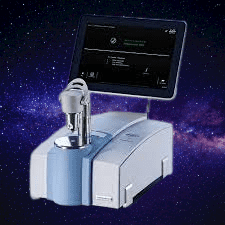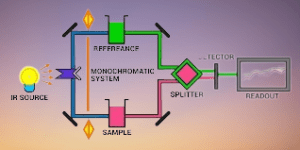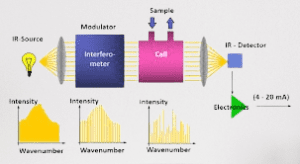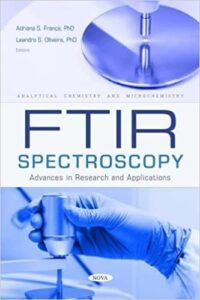FTIR spectroscopy (Fourier Transform Infrared Spectroscopy) is a powerful analytical technique that is used to study the vibrational modes of molecules. It measures the absorption or transmission of infrared radiation by a sample, which allows for the identification of functional groups and chemical bonds within a molecule.
FTIR spectroscopy works by passing infrared light through a sample and measuring the amount of light absorbed or transmitted by the sample at various frequencies. The resulting spectrum can then be used to identify the functional groups and chemical bonds present in the sample.
Some typical applications of FTIR spectroscopy include the identification of unknown compounds, the characterization of polymers, and the analysis of protein structure. It is also widely used in forensic science, environmental monitoring, and pharmaceutical development.
FTIR spectroscopy has many advantages over other analytical techniques. It is non-destructive, meaning that the sample can be used for further analysis after the measurement is complete. It is also a relatively fast and inexpensive technique that requires very little sample preparation.
What is the complete form of FTIR.
The complete form of FTIR is Fourier Transform Infrared Spectroscopy.

Principle of FTIR spectroscopy (Fourier Transform Infrared Spectroscopy) in QC.
The principle of FTIR spectroscopy in Quality Control (QC) involves measuring the absorption or transmission of infrared radiation by a sample to obtain its Fourier Transform Infrared spectrum. The spectrum is then analyzed to identify the functional groups and chemical bonds present in the sample.
In QC, FTIR spectroscopy is typically used to analyze the chemical composition of materials. It is a powerful tool for identifying unknown compounds, verifying the identity of a known compound, and detecting impurities or contaminants in a sample.
The basic principle of FTIR spectroscopy involves passing infrared radiation through a sample and measuring the amount of radiation absorbed or transmitted at different frequencies. The resulting spectrum provides information about the chemical bonds and functional groups present in the sample.
FTIR spectrometers work by measuring the interference pattern created by an interferometer. The interferometer splits the infrared radiation into two beams, which travel through the sample and reference material before recombining. The interference pattern is then transformed into a spectrum using Fourier transformation.
The resulting spectrum is a unique fingerprint of the sample’s chemical composition and can be compared to reference spectra to identify the compound. FTIR spectroscopy is a powerful tool in QC because it is non-destructive, requires minimal sample preparation, and can provide rapid, accurate analysis of a wide range of materials.
Technical data of FTIR spectroscopy.
ftir instrumentation
| Technical Data | Description |
| Wavelength Range | Typically 4000 – 400 cm<sup>-1</sup> |
| Spectral Resolution | Typically 0.5 – 2 cm<sup>-1</sup> |
| Signal-to-Noise Ratio | Typically > 20,000:1 |
| Sampling Techniques | Transmission, Attenuated Total Reflectance (ATR), Diffuse Reflectance (DRIFTS), and Reflection-Absorption (RAIRS) |
| Sample Requirements | Typically a small amount of solid or liquid sample is required |
| Instrument Size | Bench-top to floor-standing, depending on the complexity of the instrument and the applications |
| Applications | Identification of unknown compounds, characterization of polymers, analysis of protein structure, forensic science, environmental monitoring, pharmaceutical development, and more |
| Advantages | Non-destructive, rapid, requires minimal sample preparation, and can analyze a wide range of materials |
| Limitations | Limited sensitivity for trace analysis, may require specific sample preparation for certain applications, and may not be suitable for some materials such as metals or highly absorbing materials |
Applications of FTIR spectroscopy
FTIR spectroscopy (Fourier Transform Infrared Spectroscopy) has a wide range of applications in many fields, including chemistry, biology, physics, materials science, pharmaceuticals, and more. Some common applications of FTIR spectroscopy are:
-
- Identification of unknown compounds: FTIR spectroscopy is a powerful tool for identifying unknown compounds based on their unique infrared spectra. It can be used in forensic science, environmental monitoring, and chemical analysis.
- Characterization of polymers: FTIR spectroscopy is commonly used to study the composition, structure, and properties of polymers, such as plastics, rubbers, and fibers.
- Analysis of protein structure: FTIR spectroscopy is used to study the structure and conformational changes of proteins, as well as protein-ligand interactions.
- Chemical analysis: FTIR spectroscopy is widely used for qualitative and quantitative analysis of chemical compounds, including organic and inorganic materials, as well as biological samples.
- Quality control: FTIR spectroscopy is used in manufacturing and production industries for quality control of materials and products. It can identify impurities and contaminants in raw materials and finished products, as well as monitor chemical reactions and processes.
- Environmental monitoring: FTIR spectroscopy can be used to monitor air and water pollution, as well as identify and quantify contaminants in soil and other environmental samples.
- Medical diagnostics: FTIR spectroscopy is being investigated as a tool for medical diagnostics, such as detecting cancer cells in tissue samples and monitoring blood glucose levels in diabetes patients.
These are just a few examples of the many applications of FTIR spectroscopy. The versatility and wide range of applications of FTIR spectroscopy make it a valuable tool in many scientific and industrial fields.

Advantages and disadvantages of FTIR spectroscopy
| Advantages | Disadvantages |
| Non-destructive analysis. | Limited sensitivity for trace analysis. |
| Rapid analysis time. | Can be affected by sample preparation, such as grinding or pressing. |
| Requires minimal sample preparation. | May not be suitable for some materials, such as metals or highly absorbing materials. |
| Can analyze a wide range of materials, including solids, liquids, and gases. | May require specific sampling techniques for certain materials or applications. |
| High selectivity and specificity for identifying functional groups and chemical bonds. | The quality of the data can be affected by factors such as instrument calibration, temperature fluctuations, and atmospheric conditions. |
| Can be used for qualitative and quantitative analysis. | Some materials may require specialized analysis techniques, such as ATR or DRIFTS, which can be more complicated and expensive. |
| Versatile, with applications in many fields, such as chemistry, biology, materials science, and more. | The initial cost of the instrument can be high, depending on the complexity and capabilities of the instrument. |
FAQ
What is the difference between FTIR spectroscopy and other spectroscopic techniques?
Answer: FTIR spectroscopy uses a Fourier transform to convert the time-domain data to the frequency-domain, allowing for high resolution and sensitivity in the resulting spectra. Other spectroscopic techniques, such as UV-Vis spectroscopy or NMR spectroscopy, use different methods to analyze the interaction of light or radiation with a sample.
What is the importance of spectral resolution in FTIR spectroscopy?
Answer: Spectral resolution refers to the ability of the instrument to distinguish between two closely spaced spectral peaks. The higher spectral resolution allows for more precise identification and quantification of sample components. This is particularly important in complex samples where multiple components may be present.
How does the choice of sampling technique affect the FTIR spectra obtained?
Answer: Different sampling techniques, such as transmission, ATR, DRIFTS, or RAIRS, can affect the intensity, shape, and position of the spectral peaks obtained. The choice of sampling technique depends on the nature of the sample, its physical state, and the specific analysis required.
How does FTIR spectroscopy contribute to the field of pharmaceutical development?
Answer: FTIR spectroscopy can be used for qualitative and quantitative analysis of drugs, excipients, and formulations, as well as for monitoring drug stability, degradation, and impurities. It can also be used to study drug-protein interactions and drug delivery systems.
Can FTIR spectroscopy be used for the analysis of biological samples?
Answer: Yes, FTIR spectroscopy is commonly used for the analysis of biological samples such as proteins, lipids, nucleic acids, and carbohydrates. It can provide information about the secondary structure, conformational changes, and interactions of these biomolecules.
What is the role of FTIR spectroscopy in forensic science?
Answer: FTIR spectroscopy can be used to identify unknown substances, such as drugs or explosives, in forensic investigations. It can also be used to analyze trace evidence, such as fibers or paint chips, and to study the chemical composition of gunshot residue.
How can FTIR spectroscopy be used for environmental monitoring?
Answer: FTIR spectroscopy can be used to monitor air and water pollution, as well as to identify and quantify contaminants in soil and other environmental samples. It can provide information about the chemical composition of these samples, including the presence of hazardous compounds.
What are the advantages of ATR sampling in FTIR spectroscopy?
Answer: ATR sampling allows for analysis of samples without any sample preparation, and can be used for analysis of a wide range of sample types, including liquids, powders, and solids. It also provides good spectral resolution and sensitivity.
How can FTIR spectroscopy be used for quality control in the manufacturing industry?
Answer: FTIR spectroscopy can be used to identify impurities and contaminants in raw materials and finished products, as well as to monitor chemical reactions and processes. It can provide real-time feedback on the quality of materials and products, allowing for adjustments to be made during production.
What are the limitations of FTIR spectroscopy in analysis of complex samples?
Answer: In complex samples, such as mixtures or multicomponent systems, it can be difficult to assign specific peaks to individual components. There may also be interference from overlapping peaks or baseline effects. Specialized data processing and analysis techniques may be required to accurately analyze such samples.

